Pioneer AVIC-F710BT User Manual [en, de, es, fr, it]
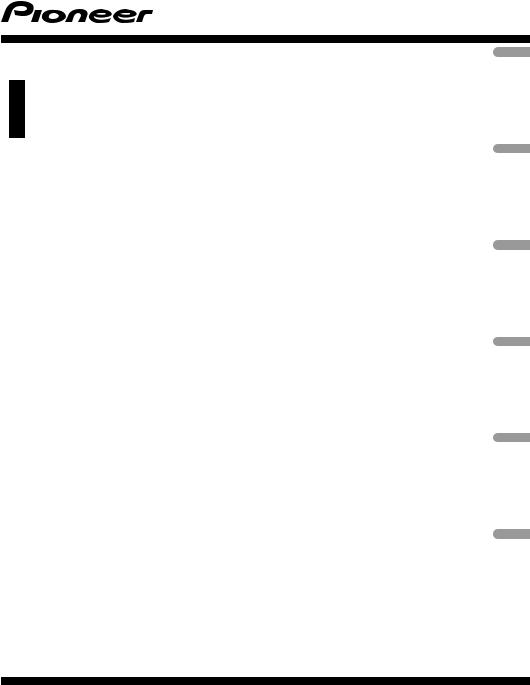
INSTALLATION MANUAL MANUEL D’INSTALLATION
NAVIGATION AV SYSTEM
SYSTEME DE NAVIGATION AV
AVIC-F910BT AVIC-F710BT
Nederlands Italiano Français Deutsch Español English


 Contents
Contents
 IMPORTANT INFORMATION
IMPORTANT INFORMATION
ABOUT YOUR NEW NAVIGATION SYSTEM AND THIS MANUAL 3
 IMPORTANT SAFEGUARDS
IMPORTANT SAFEGUARDS
PLEASE READ ALL OF THESE INSTRUCTIONS REGARDING YOUR NAVIGATION SYSTEM AND RETAIN THEM
FOR FUTURE REFERENCE |
4 |
|
|
||||
Connecting the System |
|
|
|
||||
Precautions before connecting the |
|
||||||
system 5 |
|
|
|
|
|
|
|
Before installing this product |
6 |
|
|
||||
To prevent damage |
6 |
|
|
|
|
||
– Notice for the blue lead |
6 |
|
|
||||
– Notice for the blue/white lead |
7 |
||||||
Parts supplied |
7 |
|
|
|
|
|
|
Connecting the system |
8 |
|
|
|
|||
Connecting the power cord (1) |
10 |
|
|||||
Connecting the power cord (2) |
12 |
|
|||||
When connecting to separately sold power |
|||||||
amp 14 |
|
|
|
|
|
|
|
When connecting a rear view camera |
16 |
||||||
When connecting the rear display |
17 |
||||||
– |
When using a rear display connected to |
||||||
|
rear video output |
17 |
|
|
|
||
When connecting the external video |
|
||||||
component |
17 |
|
|
|
|
|
|
– Using “AV1 Input” (AV1) |
17 |
|
|
||||
– Using “AV2 Input” (AV2) |
18 |
|
|
||||
Installation |
|
|
|
|
|
|
|
Precautions before installation |
19 |
|
|||||
To guard against electromagnetic |
|
|
|||||
interference |
19 |
|
|
|
|
|
|
Before installing 20 |
|
|
|
|
|
||
Installing this navigation system |
20 |
|
|||||
– |
Installation notes |
20 |
|
|
|
||
– |
Parts supplied |
21 |
|
|
|
|
|
– |
Before installing this navigation |
|
|
unit 22 |
|
– |
Installation with the holder and side |
|
|
bracket 22 |
|
– |
Installation using the screw holes on |
|
|
the side of the navigation unit 23 |
|
Installing the GPS aerial |
24 |
|
– |
Installation notes |
24 |
– |
Parts supplied 24 |
|
–When installing the aerial inside the vehicle (on the dashboard or rear shelf) 25
Installing the microphone 26 |
|
|
– |
Parts supplied 26 |
|
– |
Mounting on the sun visor 26 |
|
– |
Installation on the steering column 27 |
|
– |
Adjusting the microphone angle |
28 |
After Installation |
|
|
After Installing this navigation system |
29 |
|
 2
2 Engb
Engb

 IMPORTANT INFORMATION
IMPORTANT INFORMATION
ABOUT YOUR NEW NAVIGATION SYSTEM AND THIS MANUAL
!The navigation features of this product (and rear view camera option if purchased) are intended solely to aid you in the operation of your vehicle. It is not a substitute for your attentiveness, judgement and care when driving.
!Never use this navigation system to route to hospitals, police stations, or similar facilities in an emergency. Please call the appropriate emergency number.
!Do not operate this navigation system (or the rear view camera option if purchased) if doing so in any way will divert your attention from the safe operation of your vehicle. Traffic restrictions and advisories currently in force should always take precedence over guidance given by this product. Always obey current traffic restrictions, even if this product provides contrary advice.
!This manual explains how to install this navigation system in your vehicle. Operation of this navigation system is explained in the separate manuals for the navigation system.
!Do not install this product where it may (i) obstruct the driver’s vision, (ii) impair the performance of any of the vehicle’s operating systems of safety features, including airbags, hazard lamp buttons or (iii) impair the driver’s ability to safely operate the vehicle. In some cases, it may not be possible to install this product because of the vehi-
cle type or the shape of the vehicle interior.
Section
01
English
Engb |
3 |

Section
02  IMPORTANT SAFEGUARDS
IMPORTANT SAFEGUARDS
 WARNING
WARNING
Pioneer does not recommend that you install your navigation system yourself. We recommend that only authorised Pioneer service personnel, who have special training and experience in mobile electronics, set up and install this product. NEVER SERVICE THIS PRODUCT YOURSELF. Installing or servicing this product and its connecting cables may expose you to the risk of electric shock or other hazards, and can cause damage to the navigation system that is not covered by warranty.
siderably more severe if your seat belt is not properly fastened.
7In certain countries, laws may restrict the placement and use of navigation systems in your vehicle. Please comply with all applicable
laws and regulations in the installation and operation of your navigation system.
PLEASE READ ALL OF THESE INSTRUCTIONS REGARDING YOUR NAVIGATION SYSTEM AND RETAIN THEM FOR FUTURE REFERENCE
1Read this manual fully and carefully before installing your navigation system.
2Keep this manual handy for future reference.
3Pay close attention to all warnings in this manual and follow the instructions carefully.
4This navigation system may in certain circumstances display erroneous information regarding the position of your vehicle, the distance of objects shown on the screen, and compass directions. In addition, the system has certain limitations, including the inability to identify one-way streets, temporary traffic restrictions and potentially unsafe driving areas. Please exercise your own judgement in the light of actual driving conditions.
5As with any accessory in your vehicle’s interior, the navigation system should not divert your attention from the safe operation of your vehicle. If you experience difficulty in operating the system or reading the display, please make adjustments while safely parked.
6Please remember to wear your seat belt at all times while operating your vehicle. If you are ever in an accident, your injuries can be con-
4 |
Engb |

|
Section |
Connecting the System |
03 |
|
|
Precautions before connecting the system
 CAUTION
CAUTION
!If you decide to perform the installation yourself, and have special training and experience in the mobile electronics installations, please carefully follow all of the steps in the installation manual.
!Secure all wiring with cable clamps or electrical tape. Do not allow any bare wiring to remain exposed.
!Do not directly connect the yellow lead of this product to the vehicle battery. If the lead is directly connected to the battery, engine vibration may eventually cause the insulation to fail at the point where the wire passes from the passenger compartment into the engine compartment. If the yellow lead’s insulation tears as a result of contact with metal parts, short-cir- cuiting can occur, resulting in considerable danger.
!It is extremely dangerous to allow the cables to become wound around the steering column or gearstick. Be sure to install this product, its cables, and wiring away in such a way that they will not obstruct or hinder driving.
!Make sure that the cables and wires are routed and secured so they will not interfere with or become caught in any of the vehicle’s moving parts, especially the steering wheel, gearstick, handbrake, sliding seat tracks, doors, or any of the vehicle’s controls.
!Do not route wires where they will be exposed to high temperatures. If the insulation heats up, wires may become damaged, resulting in a short circuit or malfunction and permanent damage to the product.
!Do not cut the GPS aerial cable to shorten it or use an extension to make it longer. Altering the aerial cable could result in a short circuit or malfunction.
!Do not shorten any leads. If you do, the protection circuit (fuse holder, fuse resistor or filter, etc.) may fail to work properly.
!Never feed power to other electronic products by cutting the insulation of the power supply lead of the navigation system and tapping into the lead. The current capacity of the lead will be exceeded, causing overheating.
!The black lead is earth. Please earth this lead separately from the earth of high-cur- rent products such as power amps. Do not earth more than one product together with the earth from another product. For example, you must separately earth any amp unit away from the earth of this navigation system. Connecting earths together can cause a fire and/or damage the
products if their earths became detached.
English
Engb |
5 |
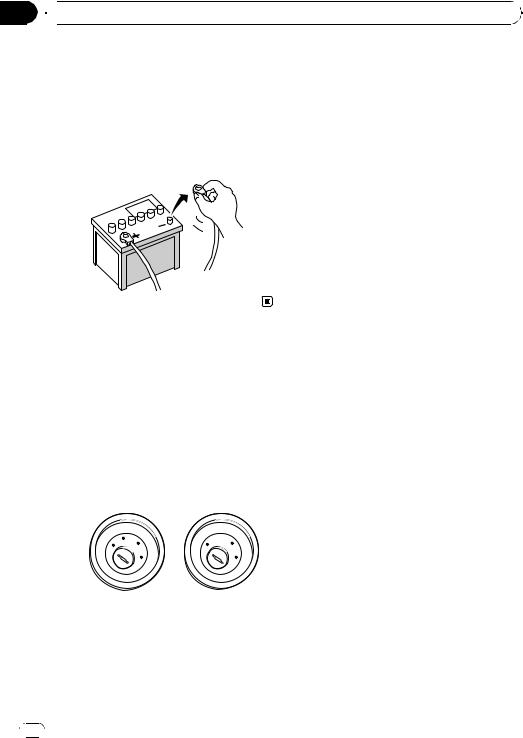
Section
03  Connecting the System
Connecting the System
Before installing this product
!This product is for vehicles with a 12-volt battery and negative earthing. Check the battery voltage of your vehicle before installation.
!To avoid shorts in the electrical system, be sure to disconnect the (–) battery cable before beginning installation.
To prevent damage
 WARNING
WARNING
!When replacing the fuse, be sure to only use a fuse of the rating prescribed on this product.
!When disconnecting a connector, pull the connector itself. Do not pull the lead, as you may pull it out of the connector.
!This product cannot be installed in a vehicle without ACC (accessory) position on the ignition switch.
|
CC |
|
|
|
|
F |
A |
O |
|
F |
O |
|
N |
N |
|||
F |
|
|
|
F |
|
O |
|
|
S |
O |
S |
|
|
|
|
||
|
|
|
T |
|
T |
|
|
|
A |
|
A |
|
|
T |
R |
|
T |
ACC position |
No ACC position |
||||
!To avoid short-circuiting, cover the disconnected lead with insulating tape. It is especially important to insulate all unused speaker leads, which if left uncovered may
cause a short circuit.
!Attach the connectors of the same colour to the corresponding coloured port, i.e., blue connector to the blue port, black to black, etc.
!Refer to the owner’s manual for details on connecting the power amp and other units, then make connections accordingly.
!Since a unique BPTL circuit is employed, do not directly earth the * side of the speaker lead or connect the * sides of the speaker leads together. Be sure to connect the * side of the speaker lead to the * side of the speaker lead on this navigation system.
!If the RCA pin jack on this product will not be used, do not remove the caps attached to the end of the connector.
!Never connect speakers with an output rating of less than 50 W channel or impedance outside of the 4 ohms to 8 ohms specifications to your navigation system. Connecting speakers with output and/or impedance values other than those noted here may result in the speakers catching fire, emitting smoke, or becoming damaged.
Notice for the blue lead
!A signal is output through the blue lead to control the aerial of your vehicle. The timing varies depending on the setting. (For more detailed information on changing [Ant CTRL] mode, refer to “Operation Manual”.)
!When [Ant CTRL] mode is set to [Radio], the vehicle’s aerial can be stowed or turned off by following the instructions below.
—Change the source from radio (MW/LW or FM) to another source.
—Turn the source off
—Turn off the ignition switch (ACC OFF)
!If [Ant CTRL] mode is set to [Power], the vehicle’s aerial can be stowed or turned off only when the ignition switch is turned off (ACC OFF).
 6
6 Engb
Engb
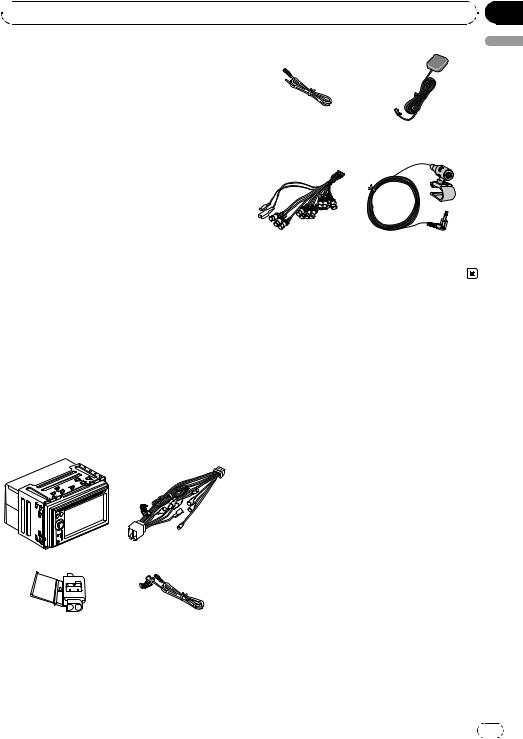
 Connecting the System
Connecting the System
! Do not connect this lead to the system con- |
|
|
trol terminal of external power amps. |
|
|
! Be sure not to use this lead as the power |
|
|
supply lead for the auto-aerial or aerial |
|
|
booster. Such connection could cause ex- |
|
|
cessive current drain and malfunction. |
Extension lead* |
GPS aerial |
|
(for speed signal) |
|
Notice for the blue/white lead
! When the ignition switch is turned on (ACC ON), a control signal is output through the blue/white lead. Connect to an external power amp’s system remote control terminal (max. 300 mA 12 V DC). The control signal is output through the blue/white lead,
even if the audio source is switched off. |
RCA connector |
Microphone |
|
|
!Do not connect this lead to the auto-aerial relay control terminal or the aerial booster power control terminal.
!Be sure not to use this lead as the power supply lead for the external power amps.
Such connection could cause excessive current drain and malfunction.
Parts supplied
Parts marked (*) are not supplied with AVIC-
F710BT.
Section
03
English
The navigation unit |
Power cord |
Connector* |
Extension lead |
|
(for reverse signal) |
Engb |
7 |
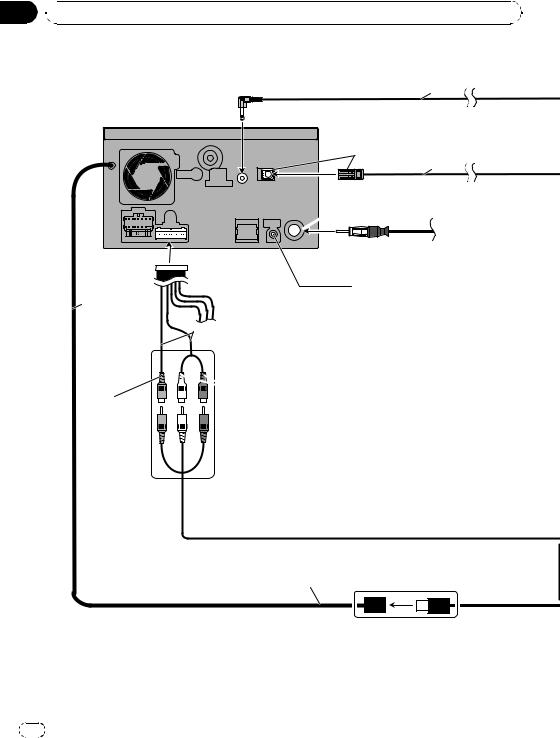
Section
03 Connecting the System
Connecting the System
Connecting the system
4 m
The navigation unit
Green
5 m
Aerial
 jack
jack
Vehicle aerial
RCA connector
|
WIRED REMOTE INPUT |
|
2 m |
Please see the Instruction |
|
Manual for the Wired Remote |
||
|
||
|
Control Adapters (sold separately). |
|
|
20 cm |

 Red, white
Red, white
(AUDIO INPUT)
Yellow (VIDEO INPUT)
*1
*1
—When connecting your iPod, both connections are necessary.
—It is necessary to set [AV1 Input] in [AV Settings] to [iPod] when connecting the iPod. (For details, refer to “Operation Manual”.)
USB connector
Connect either the interface cable for iPod or an appropriate USB storage device.
*1
8 |
Engb |
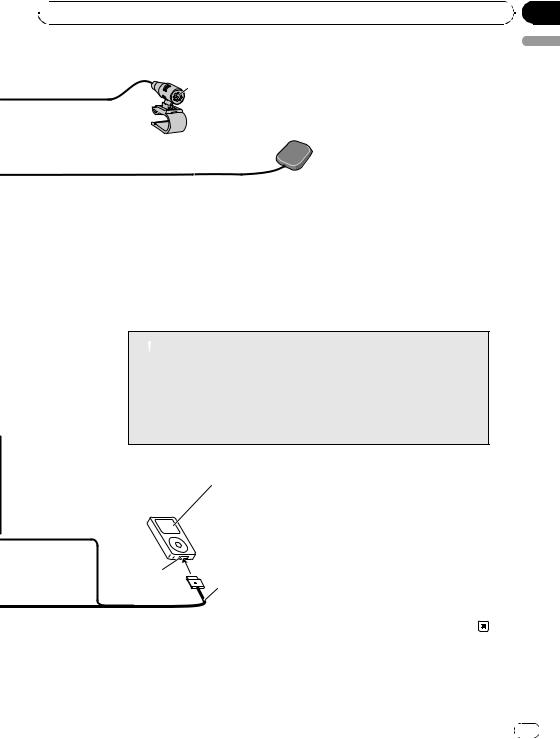
 Connecting the System
Connecting the System
Microphone
GPS aerial
Section
03
English
 WARNING
WARNING
·To avoid the risk of accident and the potential violation of applicable laws, this product should never be used while the vehicle is being driven except for navigation purposes. And, also Rear Displays should not be in a location where it is a visible distraction to the driver.
·In some countries, the viewing of images on a display inside a vehicle even by persons other than the driver may be illegal. Where such regulations apply they must be obeyed and this product´s video source should not be used.
iPod with
Dock Connector*2
*2
For details concerning operations and compatibility, refer to the operation manual.
Dock
connector
port USB Interface Cable for iPod (CD-IU230V) (sold separately)
Engb |
9 |
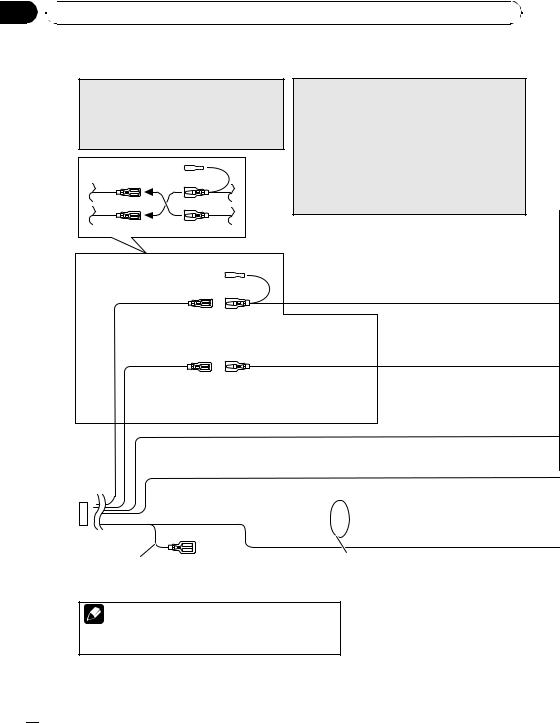
Section
03 Connecting the System
Connecting the System
Connecting the power cord (1)
 Note
Note
Depending on the kind of vehicle, the function of *3 and *5 may be different. In this case, be sure to connect *2 to *5 and *4 to *3.
*1 
 *3 *2
*3 *2
*5 *4
Cap (*1)
When not using this terminal, 
 do not remove the cap.
do not remove the cap.
 Notes
Notes
·When a subwoofer (*9) is connected to this navigation system instead of a rear speaker, change the rear output setting in the Initial Setting. (Refer to “Operation Manual”.) The subwoofer output of this navigation system is monaural.
·When using a subwoofer of 70 W (2Ω), be sure to connect with violet and violet/black leads of this navigation system. Do not connect anything with green and green/black leads.
Connect leads of the
 same colour to each other.
same colour to each other.
Yellow (*3) |
Yellow (*2) |
Back-up |
To terminal always supplied |
(or accessory) |
with power regardless of |
|
ignition switch position. |
Red (*5) |
Red (*4) |
Accessory |
To electric terminal controlled by |
(or back-up) |
ignition switch (12 V DC) ON/OFF. |
|
Orange/white |
|
To lighting switch terminal. |
|
Black (earth) |
|
To vehicle (metal) body. |
|
|
|
|
|
|
|
|
|
|
ISO connector |
|
|
||
Yellow/black |
Speaker leads |
|
||
|
If the vehicle can send a mute signal to this terminal, the |
|
||
|
White: |
Front left |
||
|
mute function can be activated on this navigation system |
White/black: |
Front left |
|
|
when the terminal is connected to *8. |
Grey: |
Front right |
|
|
|
|
Grey/black: |
Front right |
|
|
Note |
||
|
|
Green: |
Rear left or Subwoofer (*9) |
|
|
In some vehicles, the ISO connector may be divided into two. |
Green/black: Rear left or Subwoofer (*9) |
||
|
Violet: |
Rear right or Subwoofer (*9) |
||
|
In this case, be sure to connect to both connectors. |
|||
|
Violet/black: |
Rear right or Subwoofer (*9) |
||
|
|
|
||
 10
10 Engb
Engb
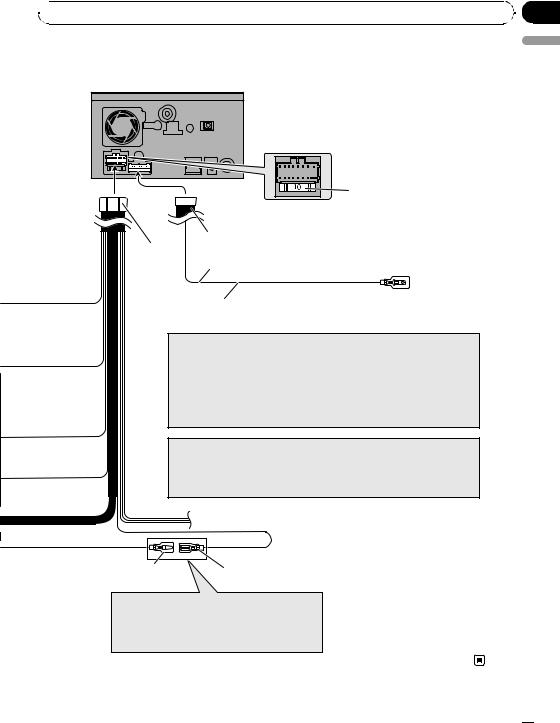
 Connecting the System
Connecting the System
The navigation unit
Fuse (10A) |
RCA connector
Power cord
16 cm |
(*8) |
Yellow/black
If you use an equipment with mute function, connect that equipment to the
Audio Mute lead. If not, keep this lead free of any connections.
 Note
Note
Audio source will be set to mute or attenuate, while the following sounds will not be muted or attenuated. For details, see “Operation Manual”.
—voice guidance of the navigation
—incoming ring tone and incoming voice of the mobile phone that is connected to this navigation system via Bluetooth wireless technology
 Note
Note
The aerial will automatically retract, yet the timing varies depending on the setting.
Blue (*6) |
Blue (*7) |
To auto-aerial relay control |
|
|
terminal (max. 300 mA 12 V DC). |
The pin position of the ISO connector will differ depending on the type of vehicle. Connect *6 and *7 when Pin 5 is an aerial control type. In other types of vehicle, never connect *6 and *7.
Section
03
English
Engb  11
11
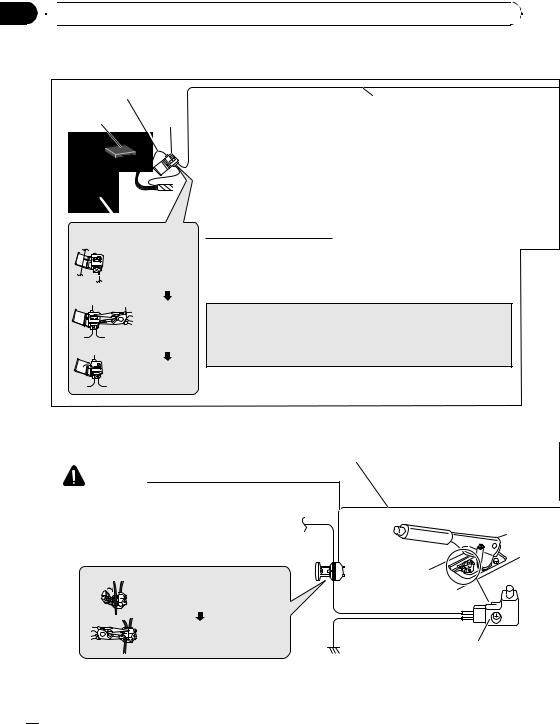
Section
03  Connecting the System
Connecting the System
Connecting the power cord (2)
Speed detection circuit lead |
3 m |
Pink (CAR SPEED SIGNAL INPUT)
Vehicle injection
computer Connector
Connection method
Pass the extension cord and the lead for
the speed detection circuit through this hole.
Clamp firmly with needlenosed pliers.
Close the cover.
This connection is unnecessary for AVIC-F710BT.
The mobile navigation system is connected here to detect the distance the vehicle travels. Always connect the vehicle´s speed detection circuit. Failure to make this connection will increase errors in the location display.
 WARNING
WARNING
IMPROPER CONNECTION MAY RESULT IN SERIOUS DAMAGE OR INJURY INCLUDING ELECTRICAL SHOCK, AND INTERFERENCE WITH THE OPERATION OF THE VEHICLE´S ANTILOCK BRAKING SYSTEM, AUTOMATIC GEARBOX AND SPEEDOMETER INDICATION.
 CAUTION
CAUTION
It is strongly suggested that the speed pulse wire be connected for accuracy of navigation and better performance.
 Note
Note
The position of the speed detection circuit and the position of the handbrake switch vary depending on the vehicle model. For details, consult your authorised Pioneer dealer or an installation professional.
Light green
Used to detect the ON/OFF status of the handbrake. This lead must be connected to the power supply side of the handbrake switch.
If this connection is made incorrectly or omitted, certain functions of your navigation system will be unusable.
WARNING
LIGHT GREEN LEAD AT POWER CONNECTOR IS DESIGNED TO DETECT PARKED STATUS AND MUST BE CONNECTED TO THE POWER SUPPLY SIDE OF THE HANDBRAKE SWITCH. IMPROPER CONNECTION OR USE OF THIS LEAD MAY VIOLATE APPLICABLE LAW AND MAY RESULT IN SERIOUS INJURY OR DAMAGE.
Connection method |
|
Clamp the handbrake switch |
Power supply side |
power supply side lead. |
|
Clamp firmly with needle-nosed |
Earth side |
|
|
pliers. |
Handbrake switch |
|
 12
12 Engb
Engb
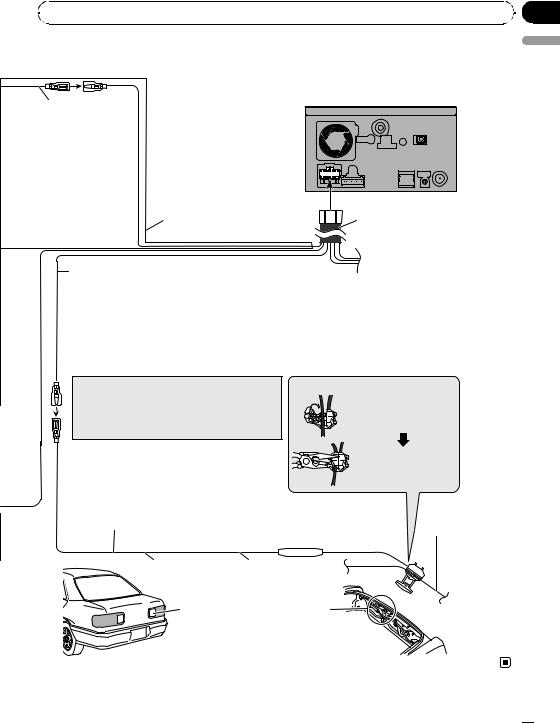
|
Section |
Connecting the System |
03 |
|
English |
Extension lead |
The navigation unit |
(for speed signal) |
|
Power cord
This connection is unnecessary for AVIC-F710BT.
Violet/white (REVERSEGEAR SIGNAL INPUT)
This is connected so that the navigation system can detect whether the vehicle is moving forwards or backwards. Connect the violet/white lead to the lead whose voltage changes when the reverse gear is engaged. Unless connected, the sensor may not detect your vehicle travelling forward/backward properly, and thus the position of your vehicle detected by the sensor may be misaligned from the actual position.
 Note
Note
When you use a rear view camera, please make sure to connect this lead. Otherwise you cannot switch to rear view camera picture.
 CAUTION
CAUTION
Connection method
Clamp the reversing lamp lead.
Clamp firmly with needle-nosed pliers.
Be sure to use only the supplied extension lead. Use of another lead could cause fire, smoke and/or damage this navigation system.
Fuse resistor
Reversing lamp lead
Extension lead |
5 m |
(for reverse signal) |
|
Check the position of your vehicle´s reversing lamp (the one that lights up when the gearstick is in reverse [R]) and find the reversing lamp lead in the boot.
Engb  13
13
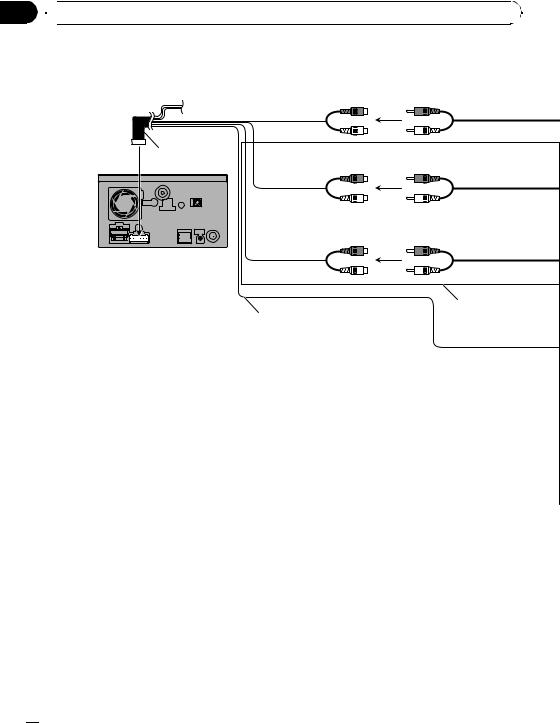
Section
03 Connecting the System
Connecting the System
When connecting to separately sold power amp
 RCA connector
RCA connector
The navigation unit
Subwoofer output (SUBWOOFER OUTPUT)
28 cm
Rear output (REAR OUTPUT)
15 cm
Front output (FRONT OUTPUT)
15 cm
30 cm
Blue/white
To system control terminal of the power amp
(max. 300 mA 12 V DC).
This connection is unnecessary for AVIC-F710BT.
 14
14 Engb
Engb
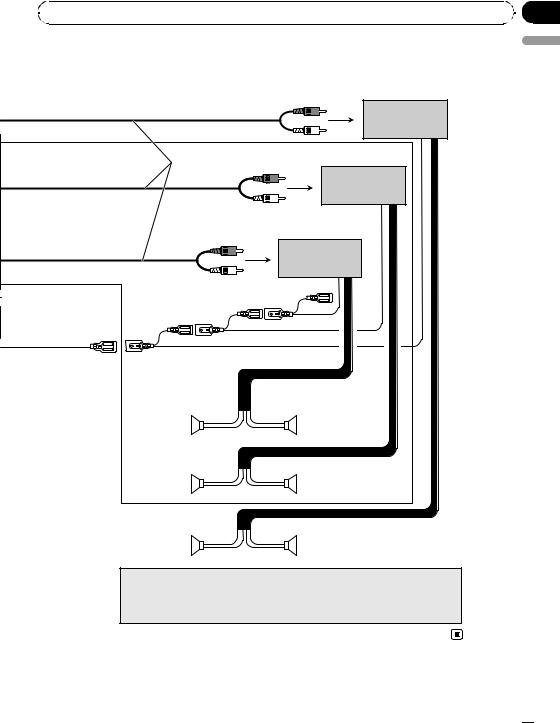
|
Section |
Connecting the System |
03 |
|
English |
|
Power amp |
|
(sold separately) |
RCA cables (sold separately)
Power amp (sold separately)
Power amp (sold separately)
System remote control |
|
Left |
Right |
|
|
Front speaker |
Front speaker |
|
|
|
|
Rear speaker |
Rear speaker |
|
|
|
|
Subwoofer |
Subwoofer |
|
|
 Note
Note
You can change the RCA output of the subwoofer depending on your subwoofer system. (Refer to “Operation Manual”.)
Engb  15
15
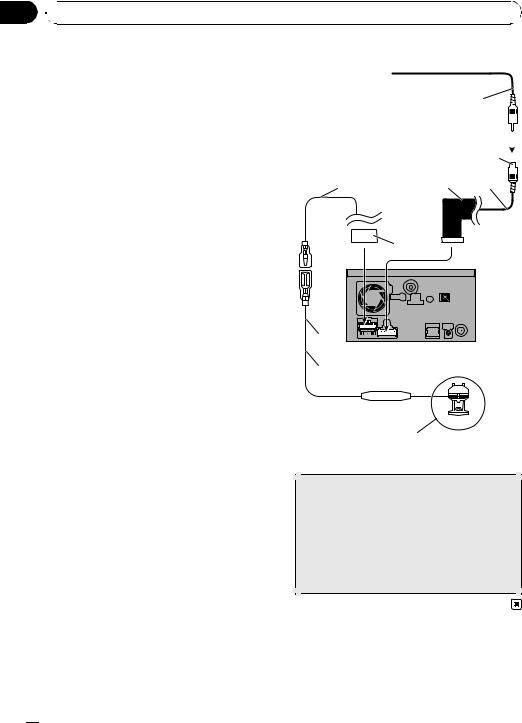
Section
03  Connecting the System
Connecting the System
When connecting a rear |
|
|
|
|
|
|
Rear view camera |
|
|
|
|
|
|
view camera |
(e.g. ND-BC2) |
To video output |
|
|
|
|
(sold separately) |
|
|
|
|||
When this product is used with a rear view |
|
RCA cable |
|
|
|
|
camera, it is possible to automatically switch |
|
|
|
|
|
|
|
|
|
|
|
|
|
from the video to rear view image when the |
|
|
|
|
|
|
gearstick is moved to REVERSE (R). Rear |
|
Brown |
|
|
|
|
View mode also allows you to check what is |
|
(REAR VIEW CAMERA IN) |
|
|
|
|
behind you while driving. |
|
|
|
|
|
|
|
|
|
|
|
|
|
 WARNING
WARNING
USE INPUT ONLY FOR REVERSE OR MIRROR IMAGE REAR VIEW CAMERA. OTHER USE MAY RESULT IN INJURY OR DAMAGE.
 CAUTION
CAUTION
!The screen image may appear reversed.
!The rear view camera function is to use this product as an aid to keep an eye on trailers, or backing into a tight parking spot. Do not use this function for entertainment purposes.
!The object in rear view may appear closer or more distant than in reality.
!Please note that the edges of the rear view camera images may differ slightly according to whether full screen images are displayed when backing, and whether the images are used for checking the rear when the vehicle is moving forward.
 CAUTION
CAUTION
Be sure to use only the supplied extension lead. Use of another lead could cause fire, smoke and/or damage this navigation system.
Violet/white |
RCA connector 20 cm |
||||
|
|
|
|
|
|
|
|
|
|
|
|
|
|
|
|
|
|
Power cord
5 m 
 The navigation unit
The navigation unit
Extension lead (for reverse signal)
Fuse resistor
For more details about the wiring, refer to Connecting the power cord (2) on page 12.
 Notes
Notes
!It is necessary to set [Back Camera] in [System Settings] to [On] when connecting the rear view camera. (For details, refer to “Operation Manual”.)
!Connect to the rear view camera. Do not connect to any other equipment.
 16
16 Engb
Engb
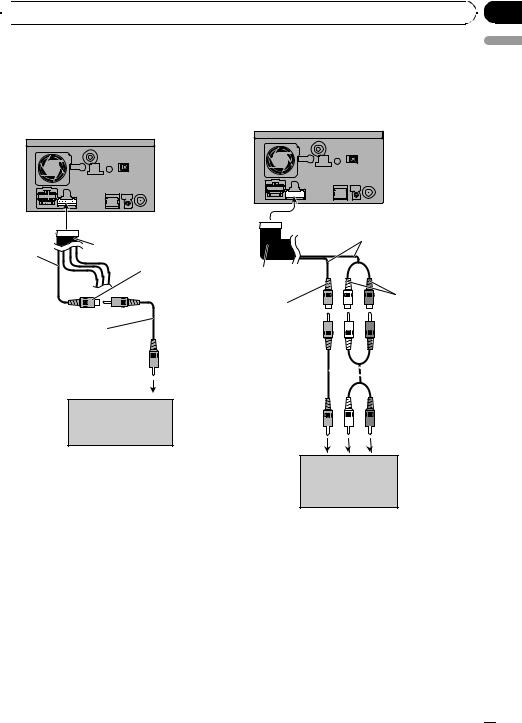
 Connecting the System
Connecting the System
When connecting the rear |
When connecting the |
|
display |
external video component |
|
This connection is unnecessary for AVIC- |
Using “AV1 Input” (AV1) |
|
F710BT. |
The navigation unit |
|
The navigation unit |
||
|
Section
03
English
RCA connector |
|
20 cm |
|
|
|
||
30 cm |
|
|
|
Yellow |
RCA connector |
|
|
(REAR MONITOR |
|
||
|
Red, white |
||
OUTPUT) |
|
||
Yellow |
(AUDIO INPUT) |
||
|
|||
|
|
||
|
(VIDEO INPUT) |
|
|
RCA cables |
|
|
|
(sold separately) |
|
|
To video input
Rear display with
RCA input jacks
When using a rear display connected to rear video output
 WARNING
WARNING
NEVER install the rear display in a location that enables the driver to watch the video source while driving.
This navigation system’s rear video output is for connection of a display to enable passengers in the rear seats to watch the video source.
 RCA cables (sold separately)
RCA cables (sold separately)
To video output |
To audio outputs |
External video component (sold separately)
!It is necessary to set [AV1 Input] in [AV Settings] to [Video] when connecting the external video component. (For details, refer to “Operation Manual”.)
Engb  17
17
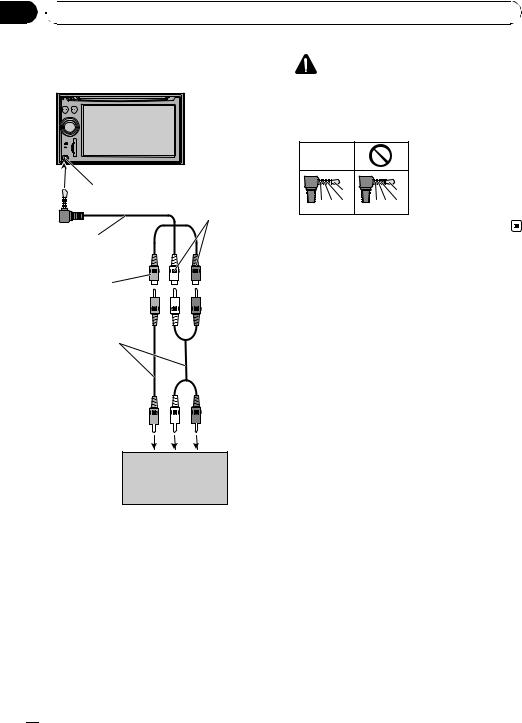
Section
03  Connecting the System
Connecting the System
Using “AV2 Input” (AV2)
|
CAUTION |
The navigation unit |
Be sure to use a CD-RM10 (sold separately) for |
|
wiring. If you use other cables, there is a case |
|
where wiring position differs, images and sounds |
|
may be disturbed. |
OK |
|
|
Mini jack |
L |
L |
V G |
R |
R G V |
Red, white |
|
|
CD-RM10 |
|
|
(sold separately) |
|
|
Yellow |
|
|
RCA cables |
|
|
(sold separately) |
|
|
To video output |
To audio outputs |
External video component (sold separately)
L : Left audio (White) R : Right audio (Red) V : Video (Yellow)
G : Earth
!It is necessary to set [AV2 Input] in [AV Settings] to [Video] when connecting the external video component. (For details, refer to “Operation Manual”.)
 18
18 Engb
Engb

|
Section |
Installation |
04 |
|
|
Precautions before installation
 CAUTION
CAUTION
!Never install this product in places where, or in a manner that:
—It could injure the driver or passengers if the vehicle stops suddenly.
—It may interfere with the driver’s operation of the vehicle, such as on the floor in front of the driver’s seat, or close to the steering wheel or gearstick.
!Make sure there is nothing behind the dashboard or panelling when drilling holes in them. Be careful not to damage fuel lines, brake lines, electronic components, communication wires or power cables.
!When using screws, do not allow them to come into contact with any electrical lead. Vibration may damage wires or insulation, leading to a short circuit or other damage to the vehicle.
!To ensure proper installation, use the supplied parts in the manner specified. If any parts other than the supplied ones are used, they may damage internal parts of this product or they may work loose and the product may become detached.
!It is extremely dangerous to allow the cables to become wound around the steering column or gearstick. Be sure to install this product, its cables, and wiring away in such a way that they will not obstruct or hinder driving.
!Make sure that leads cannot get caught in a door or the sliding mechanism of a seat, resulting in a short circuit.
!Please confirm the proper function of your vehicle’s other equipment following installation of the navigation system.
!Certain government laws may prohibit or restrict the placement and use of this system in your vehicle. Please comply with all applicable laws and regulations re-
garding the use, installation and operation of your navigation system.
!Do not install this navigation system where it may (i) obstruct the driver’s vision, (ii) impair the performance of any of the vehicle’s operating systems or safety features, including airbags, hazard lamp buttons or (iii) impair the driver’s ability to safely operate the vehicle.
!Install the navigation system between the driver’s seat and front passenger seat so that it will not be hit by the driver or passenger if the vehicle stops quickly.
!Never install the navigation system in front of or next to the place in the dash, door, or pillar from which one of your vehicle’s airbags would deploy. Please refer to your vehicle’s owner’s manual for reference to the deployment area of the frontal airbags.
!Do not install the navigation system in a place where it will impair the performance
of any of the vehicle’s operating systems, including airbags and headrests.
To guard against electromagnetic interference
In order to prevent interference, set the following items as far as possible from this navigation system, other cables or leads:
!TV aerial and aerial lead
!FM, MW/LW aerial and its lead
!GPS aerial and its lead
In addition you should lay or route each aerial lead as far as possible from other aerial leads. Do not bind them together, lay or route them together, or cross them. Such electromagnetic noise will increase the potential for errors in the location display.
English
Engb  19
19
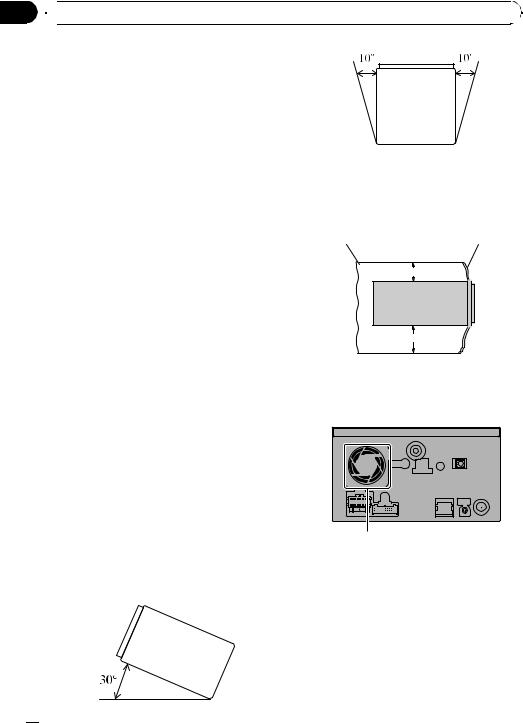
Section
04 Installation Before installing
Installation Before installing
!Consult with your nearest dealer if installation requires the drilling of holes or other modifications of the vehicle.
!Before making a final installation of this product, temporarily connect the wiring to
confirm that the connections are correct and the system works properly.
Installing this navigation system
Installation notes
!Do not install this navigation system in places where it may become subject to high temperatures or humidity, such as:
—Places close to a heater, vent or air conditioner.
—Places exposed to direct sunlight, such as on top of the dashboard.
—Places that may be splashed by rain, for example close to the door.
!Install this navigation system in an area strong enough to bear its weight. Choose a position where this navigation system can be firmly installed, and install it securely. If this navigation system is not securely installed, the current location of the vehicle cannot be displayed correctly.
!Install the navigation unit horizontally on a surface within 0 degrees to 30 degrees tolerance (within 10 degrees to the left or right). Improper installation of the unit with the surface tilted more than these tolerances increases the potential for errors in the location display, and might otherwise cause reduced display performance.
!When installing, to ensure proper heat dispersal when using this unit, make sure you leave ample space behind the rear panel and wrap any loose cables so they are not blocking the vents.
Leave ample space |
Dashboard |
5см
10см
!The cords must not cover up the area shown in the figure below. This is necessary to allow the amps and navigation mechanism to dissipate heat.
Do not cover this area.
!The semiconductor laser will be damaged if it overheats, so don’t install the navigation unit anywhere hot —for instance, near a heater outlet.
 20
20 Engb
Engb
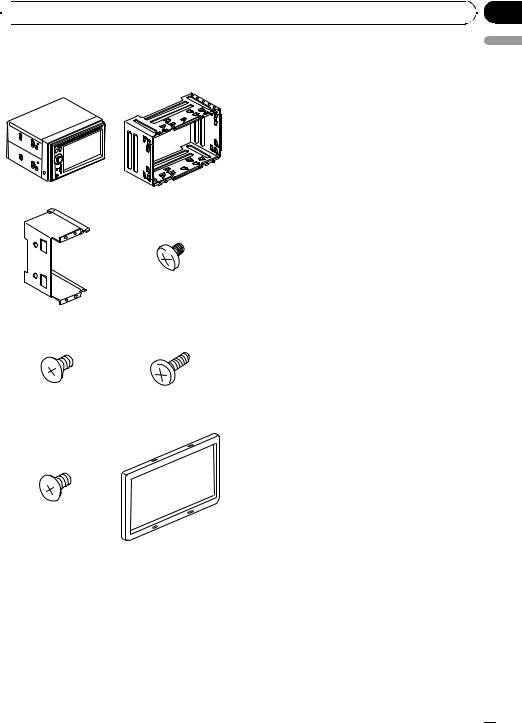
 Installation
Installation
Parts supplied
Parts marked (*) are pre-installed.
The navigation unit |
Holder* |
Side bracket* |
Binding screw |
(2 pcs.) |
(5 mm × 6 mm) |
|
(8 pcs.) |
Flush surface screw |
Screw* |
(5 mm × 6 mm) |
(3 mm × 6 mm) |
(4 pcs.) |
(8 pcs.) |
Screw for fixing the |
Trim ring |
side bracket* |
|
(5 mm × 6 mm) |
|
(4 pcs.) |
|
Section
04
English
Engb  21
21
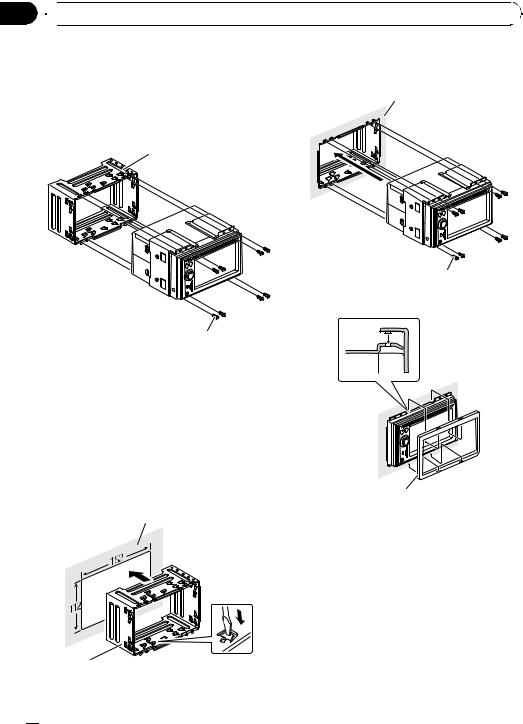
Section
04  Installation
Installation
Before installing this navigation unit
% Remove the holder.
Loosen the screws (3 mm × 6 mm) to remove the holder.
Holder
Screw (3 mm × 6 mm)
Installation with the holder and side bracket
1 Install the holder into the dashboard.
After inserting the holder into the dashboard, select and bend the tabs appropriate to the thickness of the dashboard material. (Install this navigation unit as firmly as possible using the top and bottom tabs. To secure this navigation unit, bend the tabs 90 degrees.)
Dashboard
2 Install this navigation unit and fasten the screws.
Dashboard
Screw (3 mm × 6 mm)
3 Attach the trim ring.
Trim ring
Holder
 22
22 Engb
Engb
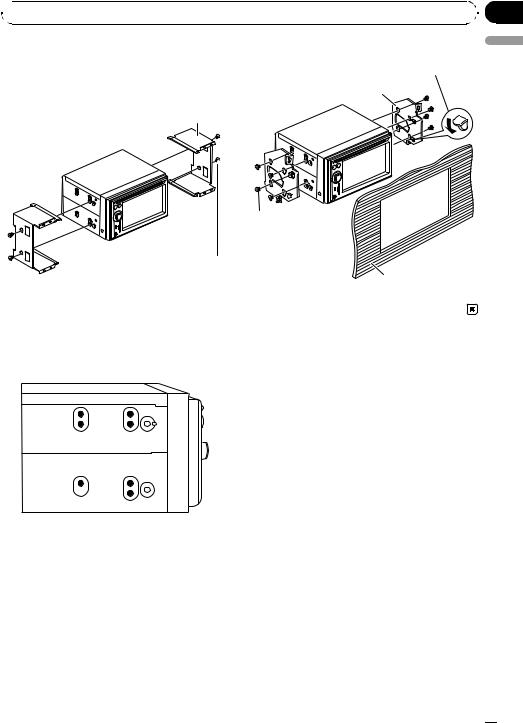
 Installation
Installation
Installation using the screw holes on the side of the navigation unit
1 Remove the side brackets.
Side bracket
Screw for fixing the side bracket (5 6 mm)
2 Fastening the navigation unit to the factory radio-mounting bracket.
Position the navigation unit so that its screw holes are aligned with the screw holes of the bracket, and tighten the screws at 3 or 4 locations on each side.
If the pawl gets in the way, bend it down
Factory radio mounting bracket
Binding screw or flush surface screw
Be sure to use the screws supplied
with this navigation
system.
Dashboard or console
Section
04
English
Engb  23
23
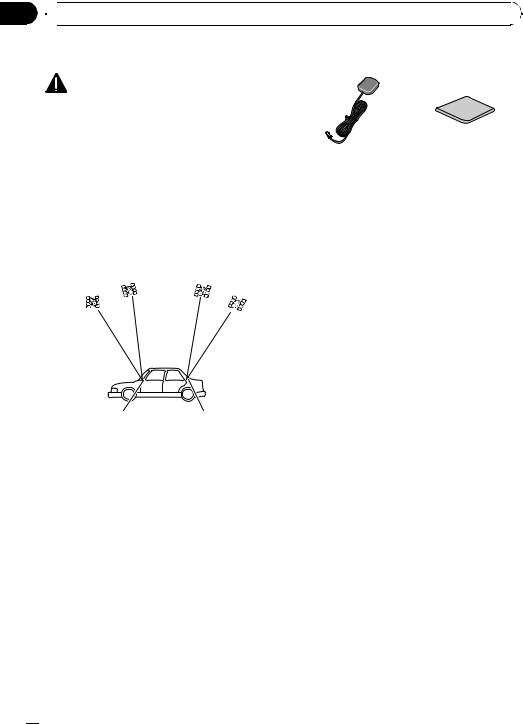
Section
04  Installation
Installation
Installing the GPS aerial |
Parts supplied |
|
|
CAUTION |
|
|
|
Do not cut the GPS aerial lead to shorten it |
|
|
|
or use an extension to make it longer. Alter- |
|
|
|
ing the aerial cable could result in a short cir- |
|
|
|
cuit or malfunction and permanent damage |
GPS aerial |
Metal sheet |
|
to the navigation system. |
|||
|
|
Installation notes
!The aerial should be installed on a level surface where radio waves will be blocked as little as possible. Radio waves cannot be received by the aerial if reception from the satellite is blocked.
|
|
|
|
|
Dashboard |
|
|
Rear shelf |
|
!When installing the GPS aerial inside the vehicle, be sure to use the metal sheet provided with your system. If this is not used, the reception sensitivity will be poor.
!Do not cut the accessory metal sheet. This would reduce the sensitivity of the GPS aerial.
!Take care not to pull the aerial lead when removing the GPS aerial. The magnet attached to the aerial is very powerful, and the lead may become detached.
!Do not paint the GPS aerial, as this may affect its performance.
 24
24 Engb
Engb

 Installation
Installation
When installing the aerial inside the vehicle (on the dashboard or rear shelf)
 WARNING
WARNING
Do not install the GPS aerial over any sensors or vents on the dashboard of the vehicle, as doing so may interfere with the proper functioning of such sensors or vents and may compromise the ability of the metal sheet under the GPS aerial to properly and securely affix to the dashboard.
Affix the metal sheet on as level a surface as possible where the GPS aerial faces the window. Place the GPS aerial on the metal sheet. (The GPS aerial is fastened with its magnet.)
GPS aerial
Metal Sheet
Peel off the protective sheet on the rear.
Make sure the surface is free of moisture, dust, grime, oil, etc., before affixing the metal sheet.
 Note
Note
The metal sheet contains a strong adhesive which may leave a mark on the surface if it is removed.
Clamps
Use separately sold clamps
to secure the lead where necessary inside the vehicle.
Section
04
English
Engb  25
25
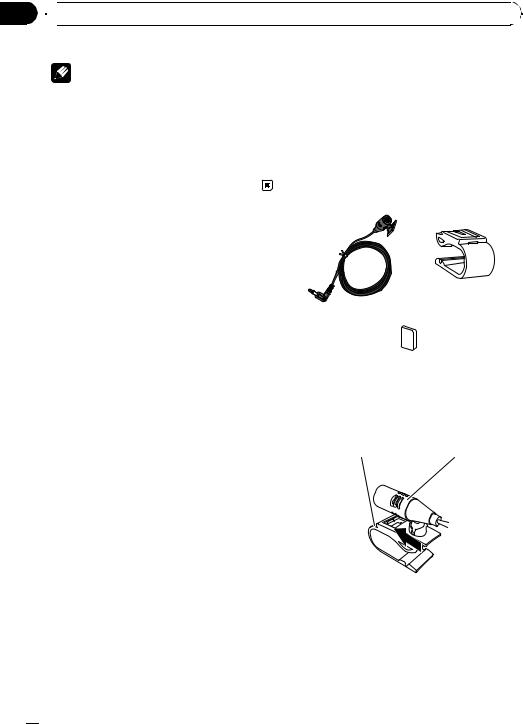
Section
04  Installation
Installation
|
|
Notes |
|
Installing the microphone |
|
|
|
||
|
|
|
! Install the microphone in a place where its |
|
|
! |
When attaching the metal sheet, do not cut |
|
|
|
|
direction and distance from the driver |
||
|
|
it into small pieces. |
|
|
|
|
|
make it easiest to pick up the driver’s voice. |
|
|
! |
Some models use window glass that does |
|
|
|
|
! Make sure to connect the microphone to |
||
|
|
not allow signals from GPS satellites to |
|
|
|
|
|
the navigation system after the system is |
|
|
|
pass through. On such models, install the |
|
|
|
|
|
turned off. (ACC OFF) |
|
|
|
GPS aerial on the outside of the vehicle. |
|
|
|
|
|
|
|
|
|
|
|
|
Parts supplied
Microphone |
Microphone clip |
Double-sided tape
Mounting on the sun visor
1 Install the microphone in the microphone clip.
Microphone clip |
Microphone |
 26
26 Engb
Engb
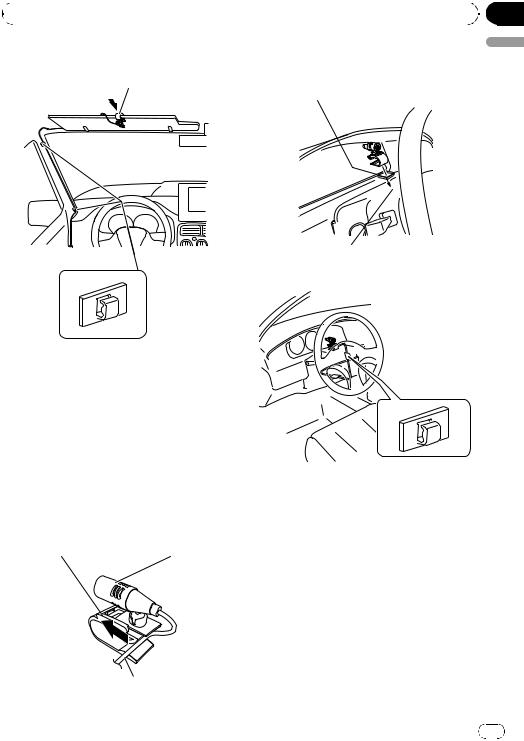
|
Section |
Installation |
04 |
|
|
2 Attach the microphone clip to sun visor.
Microphone clip
Clamps
Use separately sold clamps to secure the lead where necessary inside the vehicle.
Install the microphone on the sun visor when it is in the up position. It cannot recognise the driver’s voice if the sun visor is in the down position.
Installation on the steering column
1 Install the microphone in the microphone clip.
Microphone clip |
Microphone |
Fit the microphone cord in the groove.
2 Mount the microphone clip on the steering column.
Double-sided tape
Install the microphone clip on the steering column, keeping it away from the steering wheel.
Clamps
Use separately sold clamps to secure the lead where necessary inside the vehicle.
English
Engb 27

Section
04  Installation
Installation
Adjusting the microphone angle
The microphone angle can be adjusted.
 28
28 Engb
Engb
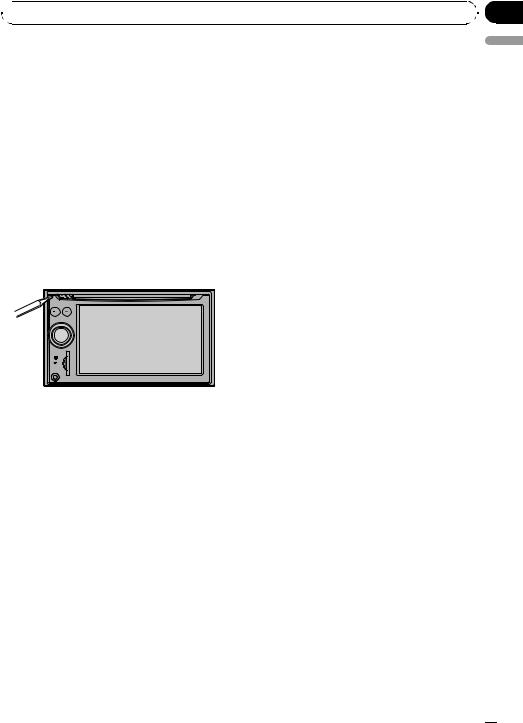
 After Installation
After Installation
After Installing this navigation system
1 Reconnecting the battery.
First, double-check that all connections are correct and that this product is installed correctly. Reassemble all vehicle components that you previously removed. Then reconnect the negative (–) cable to the negative (–) terminal of the battery.
2Start the engine.
3Press RESET button.
Press RESET button on the navigation unit using a pointed object such as the tip of a pen.
4Make the following settings:
=For details concerning operations, refer to “Operation Manual”.
1Set the language.
2Drive an unobstructed road until the GPS starts receiving the signal normally.
3Make some necessary adjustments.
!Setting the time
!Setting the units and the date format, etc.
!Change other settings as you prefer
 Note
Note
After installing this navigation system, be sure to check at a safe place that the vehicle is performing normally.
Section
05
English
Engb  29
29


 Índice
Índice
 INFORMACIÓN IMPORTANTE
INFORMACIÓN IMPORTANTE
ACERCA DE SU NUEVO SISTEMA DE NAVEGACIÓN Y ESTE MANUAL 31
 PRECAUCIONES IMPORTANTES
PRECAUCIONES IMPORTANTES
LEA TODAS ESTAS INSTRUCCIONES RELACIONADAS CON SU SISTEMA DE NAVEGACIÓN Y GUÁRDELAS PARA EMPLEARLAS COMO REFERENCIA EN EL FUTURO 32
Conexión del sistema |
|
||
Precauciones antes de conectar el |
|
||
sistema |
33 |
|
|
Antes de instalar este producto 34 |
|
||
Para impedir daños |
34 |
|
|
– Aviso para el cable conductor azul |
34 |
||
– Aviso para el cable conductor azul/ |
|
||
blanco |
35 |
|
|
Partes suministradas |
35 |
|
|
Conexión del sistema |
36 |
|
|
Conexión del cable de alimentación (1) |
38 |
||
Conexión del cable de alimentación (2) |
40 |
||
Conexión al amplificador de potencia que se vende por separado 42
Conexión de una cámara para visión trasera 44
Al conectar la pantalla posterior 45
–Al usar una pantalla posterior conectada a la salida de vídeo
|
trasera 45 |
|
Al conectar el componente de vídeo |
|
|
externo 45 |
|
|
– |
Utilización de “Entrada AV1” (AV1) |
45 |
– |
Utilización de “Entrada AV2” (AV2) |
46 |
 Instalación
Instalación
Precauciones antes de la instalación 47 Para impedir que se produzcan
interferencias electromagnéticas 48
Antes de la instalación 48 Instalación de este sistema de
navegación 48
– |
Notas acerca de la instalación 48 |
– |
Partes suministradas 49 |
–Antes de instalar esta unidad de navegación 50
–Instalación con el soporte y el soporte
lateral 50
–Instalación utilizando los orificios del tornillo al lado de la unidad de navegación 51
Instalación de la antena GPS |
52 |
|
– |
Notas acerca de la instalación 52 |
|
– |
Partes suministradas |
52 |
–Cuando instale la antena en el interior del vehículo (en el salpicadero o en la bandeja trasera) 53
Instalación del micrófono |
54 |
|
– |
Partes suministradas |
54 |
– |
Montaje en el parasol |
54 |
– |
Instalación en la columna de |
|
|
dirección 55 |
|
– |
Ajuste del ángulo del micrófono 56 |
|
 Después de la instalación
Después de la instalación
Después de instalar este sistema de navegación 57
 30
30 Es
Es
